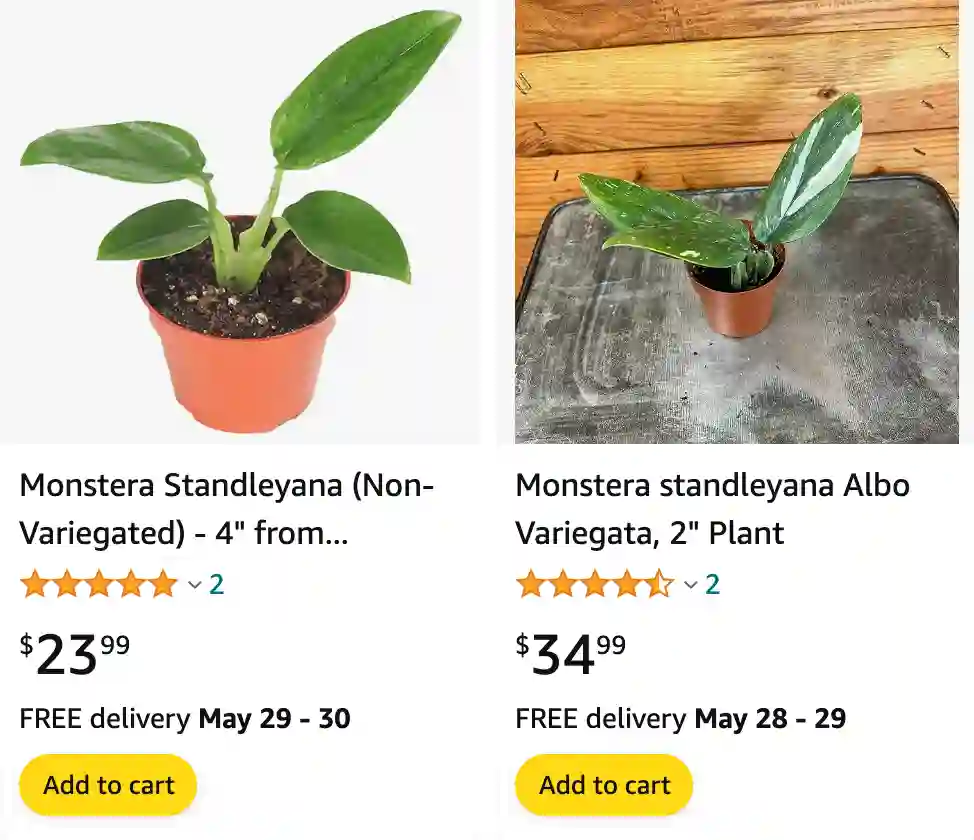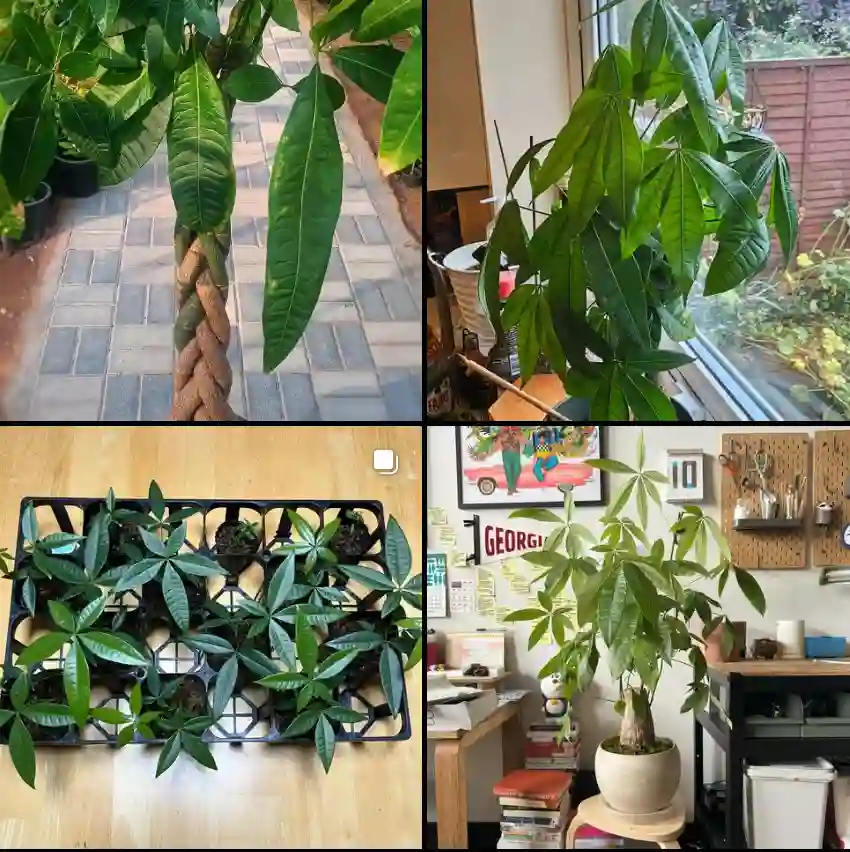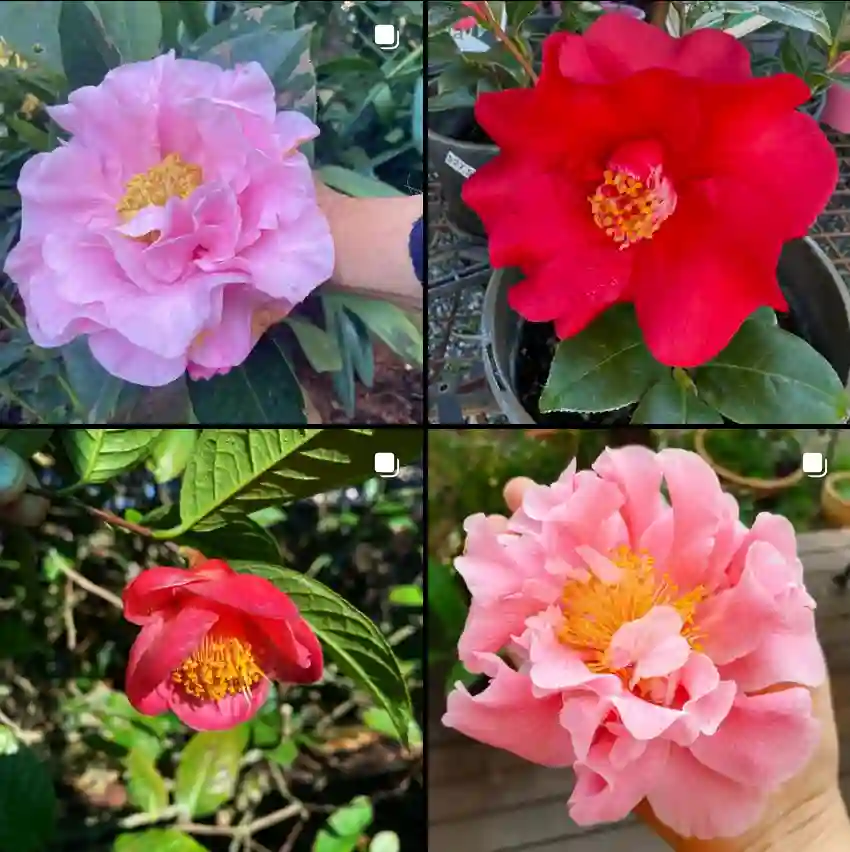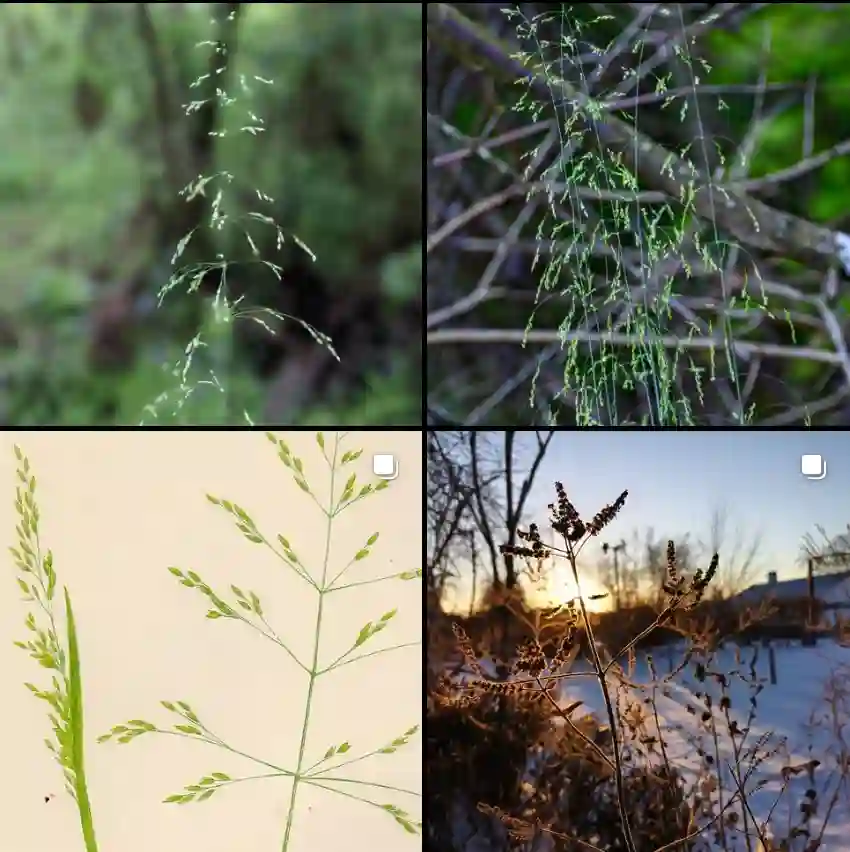
1. Introduction to Monstera Standleyana (Five Holes Plant): A Striking Aroid
1.1. What is Monstera standleyana?
Monstera standleyana, commonly known as the ‘Five Holes Plant’ or ‘Monstera Cobra’ (especially its variegated forms due to patterns resembling snake markings), is a captivating species within the Monstera genus. This plant is admired for its typically oblong to elliptical deep green leaves. While not as heavily fenestrated as Monstera deliciosa, mature M. standleyana leaves can develop subtle, elongated perforations, or often display prominent vein patterns that give the impression of “five holes” or distinct markings. Some popular cultivars feature stunning white or cream variegation, adding to its appeal. Originating from the humid regions of Central America, it is a vigorous climber that brings a touch of tropical elegance to any indoor setting.
1.2. Reasons for its Appeal
Monstera standleyana attracts plant enthusiasts for several compelling reasons:
- Distinctive Foliage: Its deep green leaves with potential for subtle fenestrations or prominent veining offer a unique aesthetic. Variegated forms with white or cream splashes are highly prized.
- Vining/Climbing Habit: It’s an excellent climber, making it ideal for moss poles, trellises, or as a hanging plant. Providing support encourages larger leaf development.
- Adaptability: It’s surprisingly adaptable to various light conditions compared to some other Monsteras, making it a relatively forgiving plant for growers.
- Elegance: Its refined appearance adds sophistication to indoor plant collections.
2. Origins and Distinguishing Characteristics
2.1. Native Habitat
Monstera standleyana is indigenous to the tropical rainforests of Central America, primarily found in countries like Costa Rica, Honduras, Nicaragua, and Panama. In its natural habitat, it grows as an epiphyte, climbing up large trees and other vegetation. It thrives in warm, humid conditions with filtered or dappled light, where its aerial roots attach to surfaces and absorb moisture and nutrients from the environment. Replicating these conditions is key to successful indoor cultivation.
2.2. Leaf Morphology and Fenestration
The leaves of Monstera standleyana are typically elongated, oblong, or elliptical, and are a rich, glossy deep green. They can sometimes have a thick, leathery texture. While the common name ‘Five Holes Plant’ might suggest prominent fenestrations, the holes on M. standleyana are often much smaller, less numerous, and more elongated than those found on M. deliciosa. In many cases, mature leaves may develop prominent vein patterns or slight puckering rather than distinct holes, giving a textured or “cobra-like” appearance, especially in variegated forms. The variegation, when present, appears as creamy white or light cream splashes and speckles.
2.3. Growth Habit and Rate
Monstera standleyana is a vigorous vining plant. It will readily climb any available support, producing strong aerial roots to anchor itself. Providing a moss pole or trellis is highly recommended, as this encourages the plant to produce larger, more mature leaves and promotes its natural growth habit. Without support, it tends to trail, resulting in smaller leaves. Its growth rate is generally moderate, though it can grow quite long, potentially reaching impressive lengths in optimal indoor conditions. It can develop long runners (leafless stems) when searching for a place to climb, especially in lower light.
2.4. Toxicity
Like many plants in the Araceae family, Monstera standleyana is considered toxic to pets (cats, dogs) and humans if ingested. It contains calcium oxalate crystals, which can cause irritation and swelling of the mouth, throat, and stomach, leading to discomfort, nausea, and other gastrointestinal issues. It is best to keep the plant out of reach of children and pets.
3. Comprehensive Care Guide: Nurturing Your Five Holes Plant
Cultivating a thriving Monstera standleyana involves providing consistent care that mimics its tropical origins, ensuring its vibrant health and unique appearance.
Table 1: Quick Care Guide for Monstera Standleyana (Five Holes Plant)
| Care Factor | Requirement Description |
|---|---|
| Light | Bright, indirect light (East/North window, few feet from South/West with sheer curtain). Avoid harsh direct sun. At least 6 hours/day. |
| Temperature | Ideal: 18-29°C (65-85°F). Avoid below 10°C (50°F) or sudden changes/drafts. |
| Humidity | High humidity preferred, 60-80%. Appreciates misting/humidifier. |
| Watering | Water when top 1-2 inches (or half) of soil is dry. Allow full drainage. Safer to underwater. Typically weekly in growing season. |
| Soil | Well-draining, airy, organic-rich mix (aroid mix, or potting mix + peat moss + perlite + orchid bark). pH 5.5-7.5. |
| Fertilization | Balanced liquid fertilizer, diluted by half, monthly or bi-monthly in spring/summer. Reduce/withhold in fall/winter. |
| Repotting | Every 1-2 years, or when root-bound, in spring. Increase pot size slightly (a few cm). |
3.1. Light Requirements
Monstera standleyana thrives in bright, indirect light. This means placing it near a window where it receives plenty of ambient light throughout the day but is shielded from direct sunbeams, especially during the harsh midday hours. East or north-facing windows are often ideal. For south or west-facing windows, place the plant a few feet away or use a sheer curtain to diffuse intense light. The plant needs at least 6 hours of indirect light per day. Direct sunlight can scorch its leaves, leading to brown burns. Insufficient light, on the other hand, can lead to slower growth, smaller leaves, leggy stems, and less vibrant foliage. Regularly rotating the plant helps ensure even exposure and balanced growth.
3.2. Temperature and Humidity
As a plant from warm, humid climates, Monstera standleyana prefers consistent temperatures between 18-29°C (65-85°F). It is crucial to protect the plant from sudden temperature drops or exposure to cold drafts (e.g., near open doors, air conditioners, or heating vents), as temperatures below 10°C (50°F) can stress the plant, slow growth, and cause leaf damage.
High humidity is vital for its health and appearance, ideally ranging from 60-80% or higher. While it can tolerate average indoor humidity, it will truly thrive with boosted moisture. Consider using a room humidifier. Grouping the plant with other moisture-loving plants or placing its pot on a pebble tray filled with water (ensuring the pot itself doesn’t sit in the water) can also help create a more humid microclimate. Crispy leaf edges or tips are often a sign of insufficient humidity.
3.3. Watering Practices
Proper watering is critical for Monstera standleyana. It prefers its soil to dry out partially between waterings to prevent root rot. A good rule of thumb is to water thoroughly when the top 1-2 inches (2.5-5 cm) of soil feels dry to the touch, or when the top half of the soil is dry. It can even tolerate the entire potting medium drying out for a few days, but this should not be a regular practice.
Ensure that the pot has excellent drainage holes and that any excess water drains out completely from the bottom. Never let the plant sit in standing water. During the active growing season (spring and summer), it will likely need more frequent watering, typically once per week. During the cooler, dormant months of fall and winter, reduce watering frequency to every 2-3 weeks.
3.4. Optimal Soil Mix and Repotting
A well-draining, airy, and nutrient-rich potting mix is essential for Monstera standleyana. This mimics the loose, organic matter it would find in its native climbing environment. An ideal mix should promote good aeration while retaining some moisture. A suitable blend can include:
- High-quality indoor potting mix (such as a standard houseplant mix)
- Peat moss or coco coir
- Perlite (coarse-grade) or pumice for drainage and aeration
- Orchid bark (large chunk) for chunkiness and improved air circulation
- A small amount of horticultural charcoal (optional) to absorb impurities
The ideal soil pH should be slightly acidic to neutral, ranging from 5.5 to 7.5.
Repotting: Repot your Monstera standleyana typically every 1-2 years, or when you notice it has become root-bound (roots growing out of drainage holes, water running straight through the pot, stunted growth). Spring is the best time to repot, as the plant is entering its active growth phase. Choose a new pot that is only a few centimeters (1-2 inches) larger in diameter than the previous one, ensuring it has ample drainage. Avoid overly large pots, as they can retain too much moisture, leading to root rot.
3.5. Fertilization Strategies
During its active growing season (spring and summer), fertilize your Monstera standleyana monthly or bi-monthly (every 4-6 weeks) with a balanced liquid or water-soluble fertilizer, diluted to half the recommended strength. A general all-purpose houseplant feed or one with a higher nitrogen value can be beneficial. This provides the necessary nutrients to support vigorous growth and maintain its unique foliage.
Reduce or completely stop fertilizing during the fall and winter months when the plant’s growth naturally slows. Over-fertilization can lead to salt buildup in the soil, which can cause root damage or “fertilizer burn” (manifesting as a white crust on the soil surface, brown leaf tips and edges, or yellowing). Always water the plant thoroughly before applying fertilizer to protect the roots.
4. Propagation Techniques: Expanding Your Collection
Propagating Monstera standleyana is a rewarding way to create new plants and expand your collection. The best time for propagation is during spring or early summer when the plant is actively growing.
4.1. Stem Cuttings
- Select a Healthy Stem: Choose a healthy, well-established stem section that has at least one node (the point where a leaf or aerial root emerges) and at least one healthy leaf. Cuttings with 2-3 leaves are often recommended for better success. If you have a variegated form, ensure the cutting includes a good amount of both green and variegated sections to maintain the desired pattern in the new plant.
- Sterilize Tools: Always use clean, sharp, and sterilized pruning shears or a knife to make your cuts. Sterilizing prevents the spread of diseases.
- Make the Cut: Cut the stem just below a node. Remove any lower leaves that would be submerged in your chosen rooting medium to prevent rot.
- Rooting Hormone (Optional): Applying a rooting hormone (powder or gel) to the cut end can stimulate faster root development.
- Rooting Medium Options:
- Water Propagation: Place the cutting in a clear jar with fresh water, ensuring the node is fully submerged. Change the water every few days to keep it clean and prevent bacterial growth. Roots typically begin to form within 2-4 weeks.
- Sphagnum Moss: Plant the cutting in moist, but not soggy, sphagnum moss. This medium is excellent for encouraging root growth due to its aeration and moisture retention properties.
- Soil: You can also plant the cutting directly into a small pot filled with a well-draining, airy potting mix suitable for aroids. Keep the soil consistently moist but not soggy.
- Provide Optimal Environment: Place your cuttings in a warm location that receives bright, indirect light. High humidity (e.g., within a propagation box or covered with a clear plastic bag to create a mini-greenhouse effect) will significantly accelerate the rooting process.
- Potting Up: Once the roots are a few inches long (for water or moss propagation) or significant new leaf growth is visible (for soil propagation), your new plant is ready to be transitioned to a larger pot with its permanent potting mix.
4.2. Air Layering
Air layering is another effective propagation method. This technique involves wrapping a section of the stem with moist sphagnum moss and securing it with plastic wrap. Once roots have developed within the moss, the section is cut below the rooted area and planted in soil. This method can be particularly useful for larger, more established plants or to propagate sections with specific variegation patterns.
5. Troubleshooting Common Issues: Pests, Diseases, and Environmental Stress
While generally resilient, Monstera standleyana can encounter issues if its environmental needs are not consistently met. Prompt identification and action are crucial for maintaining its health.
Table 2: Common Problems & Troubleshooting for Monstera Standleyana
| Problem | Symptoms | Solutions/Treatment |
|---|---|---|
| Yellowing Leaves | Older, lower leaves turning yellow. | Overwatering (most common), nutrient deficiency, natural aging. Adjust watering, fertilize, check roots for rot. |
| Brown Crispy Edges/Tips | Leaves browning and feeling crispy at edges. | Low humidity, underwatering, direct sun exposure, salt buildup. Increase humidity, adjust watering, move to indirect light, flush soil. |
| Drooping Leaves | Leaves losing turgor, looking limp. | Underwatering (most common), severe overwatering (root rot), cold shock. Check soil moisture, inspect roots, ensure warmth. |
| No Fenestrations/Small Leaves | New leaves remain solid, smaller than expected. | Insufficient light, immature plant, lack of climbing support. Provide brighter indirect light, offer a moss pole, be patient. |
| Leggy Growth | Long stems with sparse leaves. | Insufficient light. Move to brighter location. Prune to encourage bushier growth. |
| Pest Infestations | Visible pests (spider mites, mealybugs, thrips, scale), sticky residue, distorted growth. | Isolate plant, treat with insecticidal soap, neem oil, or appropriate pesticides. Increase humidity. |
| Root Rot | Mushy stem base, black/brown, foul-smelling roots, yellowing/wilting. | Overwatering, poor drainage. Repot, trim rotten roots, improve drainage, reduce watering. |
| Fungal Diseases (e.g., Leaf Spot) | Various spots on leaves. | Improve air circulation, reduce humidity if too high, remove affected leaves. Fungicides if severe. |
5.1. Watering Issues
- Overwatering: This is the most common cause of problems and is more detrimental than underwatering. Symptoms include yellowing leaves (particularly older, lower ones), black/brown spots on leaves, a mushy stem near the soil line, and a foul, moldy smell from the soil. This eventually leads to root rot.
- Solution: Allow the top 1-2 inches of soil to dry out completely between waterings. Ensure the pot has excellent drainage. If root rot is suspected, unpot the plant, trim any rotted, mushy roots, and repot in fresh, well-draining soil. Reduce watering frequency.
- Underwatering: Symptoms include drooping or curled leaves, crispy brown edges or tips, and overall dull foliage. The plant may visibly wilt when thirsty.
- Solution: Increase watering frequency. Ensure you are watering thoroughly so that water drains from the bottom of the pot, indicating the entire root ball has been moistened.
5.2. Light Issues
- Insufficient Light: Leads to slow growth, smaller leaves, leggy stems (long gaps between leaves on the stem as it stretches for light), and can inhibit fenestration development.
- Solution: Move the plant to a location that receives brighter, indirect light. Consider supplementing with a grow light if natural light levels are consistently low.
- Too Much Direct Light: Harsh direct sun, especially during midday, can cause leaf burn. Symptoms include scorched, brown patches, or a faded appearance on the leaves. Variegated forms are particularly susceptible.
- Solution: Relocate the plant to a spot with filtered light, or use sheer curtains to diffuse intense sunlight.
5.3. Humidity and Temperature Stress
- Low Humidity: Often causes the leaf edges or tips to turn brown and crispy. New leaves might struggle to unfurl properly.
- Solution: Increase ambient humidity using a humidifier, pebble tray, or by grouping plants together. Regular misting can offer temporary relief but is less effective than a consistent humidity source.
- Cold Stress: Exposure to temperatures below 10°C (50°F) can severely stress the plant, leading to leaf damage, wilting, and overall decline.
- Solution: Ensure the plant is in a consistently warm environment and protected from cold drafts from windows or air vents.
5.4. Pests
Common houseplant pests like spider mites, mealybugs, thrips, and scale can occasionally infest Monstera standleyana.
- Symptoms: Visible insects (spider mites with fine webbing, mealybugs with white, cottony masses, thrips with silver streaks and black frass, scale with hard, immobile bumps), sticky residue (honeydew), or speckled, distorted leaves.
- Solution: Regularly inspect your plant, especially the undersides of leaves and stem crevices. Isolate infested plants immediately. Treat with appropriate organic pest control methods such as insecticidal soap, neem oil, or by wiping pests off with an alcohol-dipped cotton swab. Increasing humidity can help deter spider mites.
5.5. Diseases
- Root Rot: This is a serious fungal disease, almost always a result of overwatering and poorly draining soil.
- Symptoms: Yellowing, wilting leaves (even when the soil is wet), a mushy stem near the soil line, and black/brown, foul-smelling roots.
- Solution: Immediately remove the plant from its pot. Carefully inspect the roots and prune away all affected (mushy, black) sections with sterilized shears. Repot the plant in fresh, well-draining aroid mix, and adjust your watering schedule to allow the soil to dry adequately between waterings.
- Fungal Leaf Spot: Can appear as various spots on the leaves.
- Solution: Improve air circulation around the plant, reduce overly high humidity, and remove affected leaves. Fungicides may be used in severe cases.
6. Conclusion: Enjoying Your Thriving Monstera Standleyana
Monstera standleyana, with its elegant foliage and distinct growth patterns, is a truly captivating and rewarding plant to cultivate. By consistently providing it with bright, indirect light, appropriate watering, high humidity, stable warm temperatures, and a well-draining soil mix along with adequate climbing support, you can ensure your Monstera standleyana thrives. While it demands attention to its specific needs, the reward of nurturing its unique beauty and watching it flourish will bring immense satisfaction and a distinctive touch of tropical charm to your indoor space.
If i die, water my plants!



